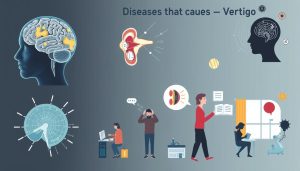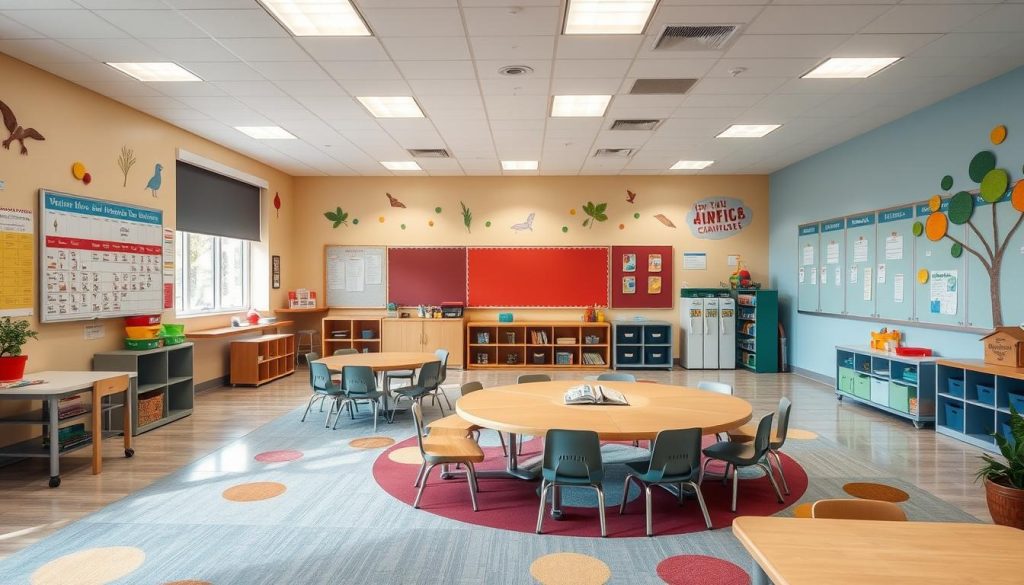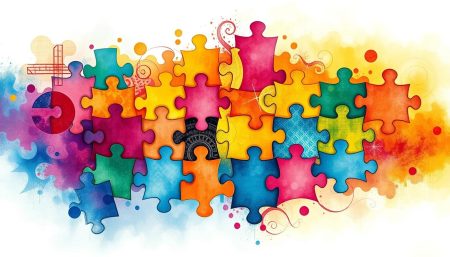Effective education for autism is a must in today’s schools. It’s about understanding and supporting the special needs of students with autism spectrum disorders (ASD). This support helps them succeed in school and life.
Teaching students with ASD requires more than just changing the curriculum. It’s about using methods that work for each student’s way of learning and communicating. This approach makes learning more personal and effective.
Good support in school can change a student’s life. It helps them feel confident and ready for the future. With the right education, students with ASD can reach their full abilities and make their mark.
Understanding Autism Spectrum Disorders in an Educational Setting
Autism Spectrum Disorders (ASDs) show a wide range of symptoms. Each person with ASD is different, making special education for autism a unique journey. Organizations like Autism Speaks help us understand ASD’s many forms. They stress the importance of education that meets each student’s needs.
Students with ASD face many challenges in school. The Autism Society points out issues like sensory sensitivities and trouble with social interactions. It’s key to recognize these challenges to create a learning space that works for autistic students.
Here’s a look at common challenges and strategies for special education for autism:
| Challenges | Possible Strategies |
|---|---|
| Sensory Overload | Creating sensory-friendly learning zones |
| Social Interaction Difficulties | Structured social skill activities and peer-mediated approaches |
| Communication Barriers | Use of visual aids and communication devices |
| Behavioral Differences | Positive behavioral interventions and supports (PBIS) |
Using autism spectrum resources well can help schools support ASD students better. It’s not just about changing classrooms and teaching methods. It’s also about making sure all staff understand and can work with ASD’s complexities.
By accepting ASD’s diversity and using flexible strategies in schools, we can improve learning for students with autism. This leads to more inclusive and supportive school environments.
How to Help Students with Autism Spectrum Disorders
Helping students with Autism Spectrum Disorders (ASD) needs a special approach. It’s about using strategies that work and finding ways to help them succeed. This way, students can do well in school and make friends.
Implementing Individualized Education Plans (IEPs)
Individualized Education Plans (IEPs) are key for students with ASD. They bring together teachers, parents, and sometimes the students to set goals. Using resources like Wrightslaw helps make these plans effective.
IEPs guide teachers on how to support each student. They help students achieve in school and grow personally.
Fostering Inclusive Classroom Environments
The National Autistic Society says inclusive classrooms are important. They help students with ASD do well in school and feel part of the group. Teachers can use structured teaching and a set schedule to help.
This makes learning easier and reduces anxiety. It helps students feel more at home in class.
Utilizing Visual Supports and Social Stories
Visual supports and social stories are very helpful for students with ASD. They make things clear and consistent. The Indiana Resource Center for Autism says they include things like schedules and guides.
Social stories teach students how to act in different situations. They help students with ASD understand and follow rules.
- Regular updates and reviews of IEPs to align with student progress and evolving needs.
- Inclusive activities that promote peer interaction and enforce positive social skills.
- Continuous education and workshops for teachers on the use of visual aids and social stories.
Using these strategies, teachers can make learning better for students with ASD. They create a welcoming and understanding classroom.
Autism Support Strategies for Teachers
Teaching students with autism needs a mix of strategies. We’ll share key methods for teaching students with autism and academic support for autism spectrum disorders. These tips improve the classroom for students with special needs.
- Adapt Teaching Styles: It’s important to adjust teaching to fit each student’s needs. Use visual aids, hands-on tools, and clear steps.
- Increase Predictability: A set schedule and environment help reduce stress. Visual schedules and clear routines make students feel secure.
- Ensure Clear Communication: Simple language avoids confusion. Add visual or written cues to help understand instructions better.
| Strategy | Benefit | Implementation Tip |
|---|---|---|
| Visual Aids | Enhances comprehension and retention | Use symbols and pictures to illustrate concepts |
| Predictable Schedules | Reduces anxiety and improves focus | Create and display a daily agenda |
| Clear Communication | Minimizes confusion and builds trust | Utilize gestures and visual prompts alongside verbal instructions |
Using these strategies in class helps a lot. Teachers can give great academic support for the autism spectrum. This way, every student can reach their full ability in a caring place.
Creating Autism-Friendly Learning Spaces
Education for autism focuses on making learning spaces that meet students’ sensory needs. These spaces help reduce distractions and sensory overload. This makes learning better and improves students’ overall well-being.
Designing Sensory-Friendly Classrooms
Creating sensory-friendly classrooms involves physical and instructional changes. Physical changes might include soft lighting or noise-cancelling materials. This helps reduce too much sound and sight.
Teachers can use visual aids and set routines to make learning calm and predictable. This helps students feel more at ease in class.
Incorporating Breaks and Quiet Areas
It’s key for schools to have quiet areas and breaks. These spots help students with autism deal with too much sensory input. Practical elements like calming colors, comfy seats, and less clutter make these areas welcoming.
- Use of non-fluorescent lighting to reduce visual stimulation
- Availability of noise-dampening headphones for auditory sensitive students
- Creation of clear and labeled personal spaces to provide structure
Tailoring Teaching Methods to Support Autism
Teaching students with autism spectrum disorder (ASD) needs special approaches. Using autism intervention techniques and adapting teaching students with autism strategies is key. These methods help students learn better.
Teachers use structured programs like the TEACCH Autism Program. This helps create learning-friendly classrooms and teaching methods. These methods make learning fun and effective for students with autism.
Important parts of these teaching methods include using visual aids and making lessons fit each student. Teachers also set up a routine in the classroom. This routine helps students feel secure and focused.
The table below shows some strategies and how they help students with ASD.
| Strategy | Description | Expected Impact |
|---|---|---|
| Visual Schedules | Use of visual tools to depict daily schedules and transitions. | Enhances understanding of daily tasks and reduces anxiety related to transitions. |
| Task Organizers | Breaking down assignments into manageable parts with visual outlines. | Improves focus and task completion by minimizing overwhelm. |
| Environmental Structuring | Organization of the physical space to promote learning and reduce distractions. | Supports sensory needs and increases on-task behavior. |
Using these strategies, based on autism intervention techniques, greatly improves learning outcomes. It also improves the quality of life for students and teachers. By tailoring teaching methods, every student can fully participate in their learning environment.
Communication Techniques for Student Engagement
Engaging students with Autism Spectrum Disorders (ASD) needs new ways to talk. Good communication is key for helping students with different learning needs. This part talks about important ways to help students with ASD, like using pictures and working with friends.
Using Non-Verbal Communication Aids
Non-verbal tools are very important for students with ASD. Picture exchange communication systems (PECS) help students who can’t talk well. These pictures make it easier to understand and help avoid getting upset.
Encouraging Peer Interaction and Social Skills Development
Social skills are important for all students, but more so for those with ASD. Programs like Social Thinking help students learn to interact with others. By doing group activities and practicing social situations, students with ASD can learn how to act and communicate better. This is a big part of helping them succeed in school and with friends.
Educational Technology and Tools for Autism
Supporting students with autism is key, and technology plays a big role. It helps them learn better and tackles unique challenges. This technology is a game-changer for their education.
Leveraging Assistive Technologies in Learning
Assistive technologies have changed the game for students with ASD. They help with communication and social skills. For example, tablets with speech apps let non-verbal students share their thoughts.
Interactive Learning Software for Students with ASD
Software made for autism can be a real game-changer. It’s designed to meet their learning needs and is backed by Autism Speaks. It keeps students engaged with fun and interactive content.
| Software | Key Features | User Friendly Rating |
|---|---|---|
| Proloquo2Go | Customizable communication boards, Speech support | High |
| ABC Mouse | Interactive games, Educational activities | Medium |
| Brain Parade | Visual learning apps, designed for ASD students | High |
These tools are essential for improving education for ASD students. They help students succeed in school and socially. With the right technology, every student can reach their full learning and social abilities.
Professional Development for Autism Support in Schools
Professional development is key in special education for autism. Teachers need ongoing learning to help teach students with autism. This ensures they use the best methods to improve learning for their students.
Many schools and groups offer special training for autism. The Organization for Autism Research is a leader. It gives educators the tools they need to meet the unique needs of students with autism.
- Understanding new diagnostic tools and interventions
- Developing skills for creating inclusive classroom environments
- Learning about the latest technologies and aids that can be incorporated into learning processes
Teachers should not just attend these sessions. They must also use what they learn in their classrooms.
| Program | Focus Area | Institution |
|---|---|---|
| Autism Spectrum Training | Behavioral Intervention Techniques | Organization for Autism Research |
| Inclusive Education Modules | Curriculum Adaptation for Autism | Special Education Association |
| Technology in Special Education | Assistive Technological Tools | Educational Technology Institute |
These programs help teachers understand and use better teaching methods for students with autism. They also keep teachers up-to-date and ready to help their students.
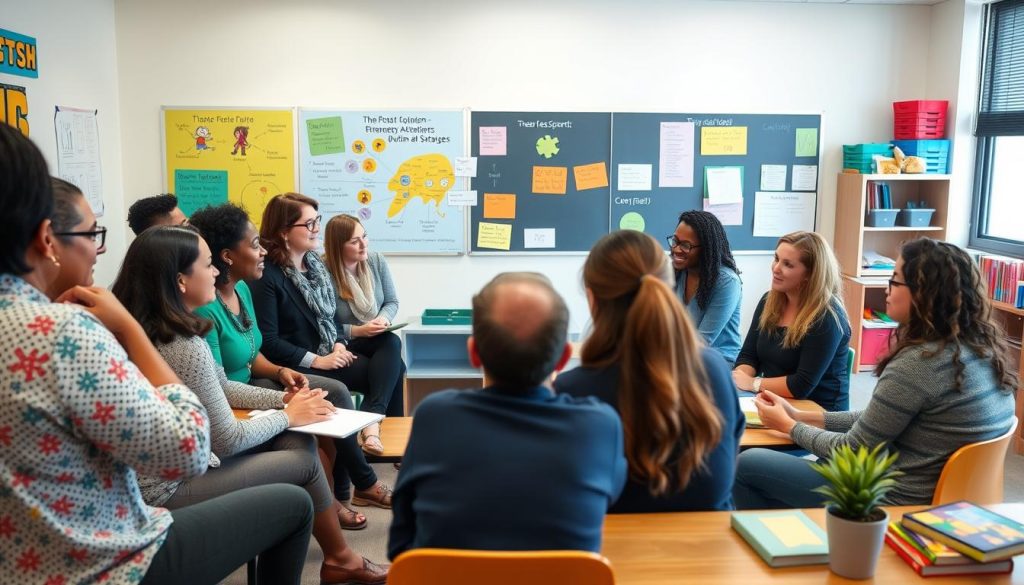
Collaborative Approaches to Autism Intervention
Helping students with Autism Spectrum Disorder (ASD) goes beyond the classroom. It needs teamwork between teachers, parents, and many experts. This teamwork boosts learning and helps students grow in all areas.
Involving Parents and Caregivers in the Educational Process
Parents and caregivers play a big role in a child’s education with ASD. Their help makes learning plans better and helps students feel more at ease. Working together with parents is key, as experts and groups agree. Understanding autism as a learning issue, not just a health one, helps parents get involved. This makes learning better for everyone.
Working With Multidisciplinary Teams for Holistic Support
Teams of experts are vital for students to succeed in school and life. These teams include teachers, therapists, and sometimes doctors. They work together to give each student the support they need.
| Team Member | Role | Impact on Student Support |
|---|---|---|
| Special Educators | Deliver personalized instruction and interventions. | Directly enhance learning and academic skills. |
| Therapists (OT, Speech, PT) | Provide essential therapy to assist in developmental skills | Support physical, communicative, and social development. |
| Behavior Specialists | Implement behavior management strategies. | Improve behavioral responses and social integration. |
This team effort makes learning and growth better for students with ASD. It creates a rich and supportive learning environment.
Behavior Management and Autism Intervention Techniques
Creating a good learning space for students with autism needs special behavior management and autism intervention techniques. Using strategies that teach positive behaviors and meet each student’s needs helps a lot. This makes learning better and more successful for them.
Positive Behavior Support Strategies
Positive behavior support (PBS) is key in handling behavioral issues in students with autism. It aims to prevent problems and teach good behaviors. It includes:
- Clear definition of expected behaviors.
- Regular and consistent positive reinforcement.
- Adaptations to the environment to minimize triggers of negative behaviors.
These methods help students behave better and make school a nicer place. They also help with social skills and schoolwork.
Understanding and Addressing Sensory Sensitivities
Many with autism are very sensitive to sounds or touch. It’s important to understand and help with these needs. Ways to help include:
- Using sensory tools such as noise-canceling headphones or weighted vests.
- Creating sensory-friendly zones in the classroom where students can retreat when overwhelmed.
- Integrating sensory breaks into the daily schedule to prevent sensory overload.
By being sensitive to these needs, we can make a learning space that’s welcoming and supportive. This lets students with autism do their best.
| Technique | Description | Benefits |
|---|---|---|
| Positive Reinforcement | Offering a reward to reinforce desirable behaviors | Increases likelihood of repeating positive behavior |
| Sensory Integration Tools | Tools designed to help manage sensory sensitivity | Reduces episodes of sensory overwhelm |
| Environment Adjustment | Modifications to physical learning spaces | Creates a safer, more engaging environment for learning |
Ways to Assist Students with ASD in Social Development
Helping students with autism spectrum disorder (ASD) in social skills is key. Many strategies and interventions can help in schools. These methods are backed by studies and experts like the Society for Research in Child Development.
- Social Skills Groups: These groups give students with ASD a safe place to learn and practice social skills.
- Peer-Mediated Interventions: Peers help students with ASD by showing them how to interact in a friendly way.
- Role-Playing Games: These games let students practice social behaviors in a controlled setting.
- Video Modeling: Students learn from videos of good social interactions, helping them in real life.
It’s also important to give regular feedback and encouragement. This helps students keep improving their social skills. Teachers can make a supportive environment that helps students with autism grow socially.
| Technique | Description | Benefits |
|---|---|---|
| Social Narratives | Stories that explain social situations and how to respond. | Helps students understand social cues and behave correctly. |
| Behavioral rehearsals | Students practice social skills in role-playing. | Improves their ability to use social skills in various situations. |
| Cooperative Learning | Activities that need teamwork and talking. | Encourages teamwork and understanding among students. |
| Self-management Techniques | Teaching students to control their own behavior in social situations. | Helps them be independent and self-controlled in social settings. |
Using these methods regularly can greatly help students with autism. It will improve their ability to interact and make friends with their peers.
Special Education Policies Impacting Students with Autism
Understanding the special education law for autism is key for educators and parents. These laws help provide the right support for students with autism. They make sure these students get the help they need to grow in school.
Navigating the Legal Aspects of Special Education for Autism
The Individuals with Disabilities Education Act (IDEA) is the foundation of autism education law. It requires schools to create special plans for each child with autism. Parents and supporters need to know their rights under IDEA to fight for their kids.
Updates to Special Education Law and Its Effect on Autism Services
New changes in special education law have greatly impacted autism services. These updates come from new research and a better understanding of autism. It’s important for everyone to stay updated on these changes to help students get the best support.
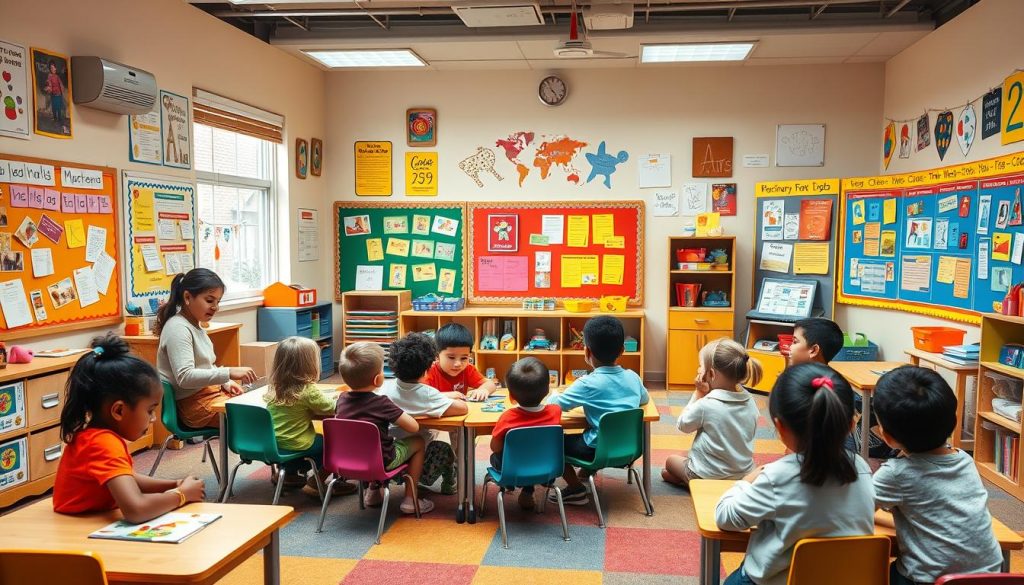
For those working in autism education, knowing the laws is not just helpful—it’s necessary. It ensures students with autism get the support they need. By using these laws, we can create a supportive learning environment for all students with autism.
Preparing for Transitions: Academic Support for Autism Spectrum
Transition planning is key for students with Autism Spectrum Disorders (ASD). Caregivers and educators work hard to support these students. They focus on preparing them for new stages in life.
Whether it’s moving from elementary to middle school or starting college, each step needs careful planning. It’s important to tailor strategies to meet each student’s unique needs.
Organizations like Autism Speaks offer valuable resources for transition planning. They stress the need to start early and focus on the student. This means assessing their skills and interests to set specific goals.
Life skills, career exploration, and community involvement are also vital. These help students prepare for their future changes.
Building a supportive network is essential. A team of teachers, therapists, and family members can offer a well-rounded approach. This ensures students have a stable environment to succeed.
With the right support, students with ASD can thrive in their transitions. They can reach their full potentials and confidently move forward.
FAQ
Q: What is the importance of understanding autism spectrum disorders in education?
A: Understanding autism spectrum disorders (ASDs) in education is key. It helps teachers tailor their teaching and classroom settings for students with ASD. This approach supports a supportive, inclusive learning environment, improving academic and social outcomes for these students.
Q: What are individualized education plans (IEPs) and why are they important for students with autism?
A: Individualized Education Plans (IEPs) are customized guides for students with disabilities, including autism. They outline specific goals, accommodations, and supports needed for success. This personalizes education to meet each student’s unique challenges and strengths.
Q: How can visual supports and social stories be used to assist students with ASD?
A: Visual supports and social stories help students with ASD by providing clear, concrete information. They reduce anxiety, improve understanding, and support positive behavior. These tools make complex information easier for students with ASD to grasp.
Q: What are some autism support strategies for teachers to implement in their classrooms?
A: Teachers can support students with autism by adapting their teaching styles and using visual aids. Creating a structured classroom routine and providing individual attention are also key. These strategies help students with autism engage with the curriculum and their learning environment.
Q: Why is creating autism-friendly learning spaces important?
A: Creating autism-friendly learning spaces is vital because students with autism often have sensory sensitivities. Sensory-friendly classrooms minimize distractions and overstimulation. This helps students with autism focus better and engage more deeply with their learning.
Q: In what ways can teaching methods be tailored to support students with autism?
A: Teaching methods can be tailored by using structured approaches and visual cues. Modifying curricular materials to meet individual learning needs is also important. Personalized teaching strategies can lead to greater academic achievement and increased student engagement for those with ASD.
Q: How can non-verbal communication aids and peer interaction facilitate engagement?
A: Non-verbal communication aids like picture exchange systems help students with ASD who struggle with verbal expression. Encouraging peer interaction and social skills development is also key. These strategies are essential for engaging students with ASD and supporting their overall development.
Q: What role does educational technology play in supporting students with autism?
A: Educational technology is vital in supporting students with autism by providing assistive tools for communication and learning. Interactive software and assistive technologies offer customized learning experiences. They make education more accessible and effective for students with ASD.
Q: Why is professional development important for educators supporting students with autism?
A: Professional development is essential for educators supporting students with autism. It equips them with the latest practices and skills needed to address the challenges and strengths of these students. Ongoing training keeps educators updated with new research and techniques, improving educational outcomes for students with ASD.
Q: How does collaborative work enhance autism intervention?
A: Collaborative work enhances autism intervention by bringing together diverse expertise. This creates a tailored support system for students with autism. Involvement from parents, educators, and multidisciplinary teams ensures a holistic approach to education and intervention, benefiting students’ academic and social development.
Q: What are effective behavior management techniques for students with autism?
A: Effective behavior management techniques for students with autism include positive behavior support strategies. These focus on reinforcing desired behaviors through rewards and praise. Addressing and accommodating sensory sensitivities also helps in creating a conducive learning environment. Tailoring responses to each student’s needs is key for successful behavior management.
Q: How can social development be supported in students with ASD?
A: Social development in students with ASD can be supported through social skills groups and peer-mediated interventions. Programs focusing on teaching social cues and interactions are also beneficial. These methods help students with autism develop relationships, understand social dynamics, and navigate various social settings.
Q: What legal aspects must educators and parents understand regarding special education for autism?
A: Educators and parents must understand the legal aspects of special education, including laws like the Individuals with Disabilities Education Act (IDEA). Knowledge of these legal requirements and rights is essential for advocating for the necessary services and resources for students with autism.
Q: What strategies are recommended for transition planning for students with autism?
A: Recommended strategies for transition planning for students with autism include early and ongoing collaboration. This involves outlining future goals and steps for reaching them. Resources and checklists from organizations like Autism Speaks are often used to ensure a smooth transition process, whether between school settings or into adulthood.




